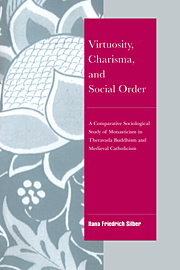 Virtuosity, Charisma and Social Order
Virtuosity, Charisma and Social Order Book contents
- Frontmatter
- Contents
- Preface
- Introduction
- Part I Virtuosi and society: elements of a comparative macrosociological approach
- Part II Virtuosi and society in Theravada Buddhism
- Part III Virtuosi and society in medieval Catholicism
- Part IV Virtuosity, charisma, and social order
- Conclusion: Religious virtuosity as ideological power: some implications for the comparative study of civilizations
- Bibliography
- Index
Conclusion: Religious virtuosity as ideological power: some implications for the comparative study of civilizations
Published online by Cambridge University Press: 09 October 2009
- Frontmatter
- Contents
- Preface
- Introduction
- Part I Virtuosi and society: elements of a comparative macrosociological approach
- Part II Virtuosi and society in Theravada Buddhism
- Part III Virtuosi and society in medieval Catholicism
- Part IV Virtuosity, charisma, and social order
- Conclusion: Religious virtuosity as ideological power: some implications for the comparative study of civilizations
- Bibliography
- Index
Summary
Like any style or method of work, comparative macrosociology has distinctive strengths but also limitations. Following the development of a constellation of variables over many centuries and across civilizations makes it perhaps possible to highlight ideal-typical formations and broad structures, but does not claim to engage in the kind of rich and detailed analysis of more limited material – something akin to Geertz's programmatic call for “thick description” – better able to render the rich texture and “fine grain” of social life. Although this is true of any aspect of social life in general, I find the problem especially acute and challenging, for my own purposes, concerning the study of cultural orientations in particular. Stating the dilemma from the Weberian angle, the problem is how to conciliate the Weberian quintessential emphasis on the interpretation of meaning and the equally Weberian emphasis on the importance of multifactorial comparative sociological analysis.
The aim of the two preceding chapters was, first, to define the essential features of the virtuoso–society complex, and second, to identify the ideological and institutional forces shaping the expression of this complex in the two civilizations in which it achieved its fullest deployment. Having thus gone through rather “normal” motions of a comparative macroscopic analysis, I intend now to probe a bit further into the ideological appeal and symbolic meaning of virtuoso elites.
- Type
- Chapter
- Information
- Virtuosity, Charisma and Social OrderA Comparative Sociological Study of Monasticism in Theravada Buddhism and Medieval Catholicism, pp. 211 - 222Publisher: Cambridge University PressPrint publication year: 1995


